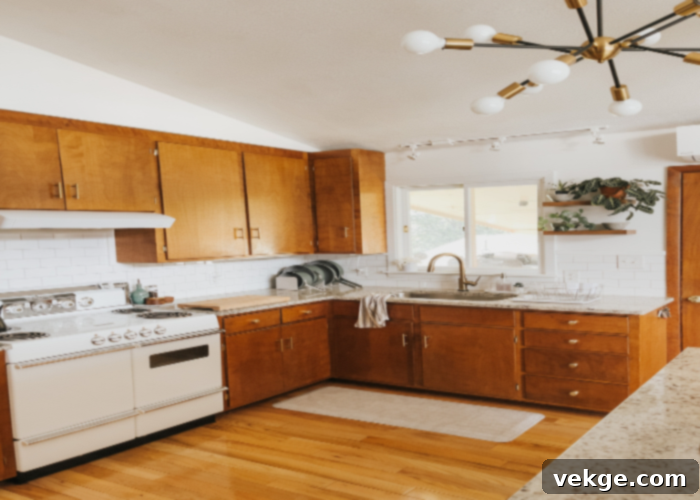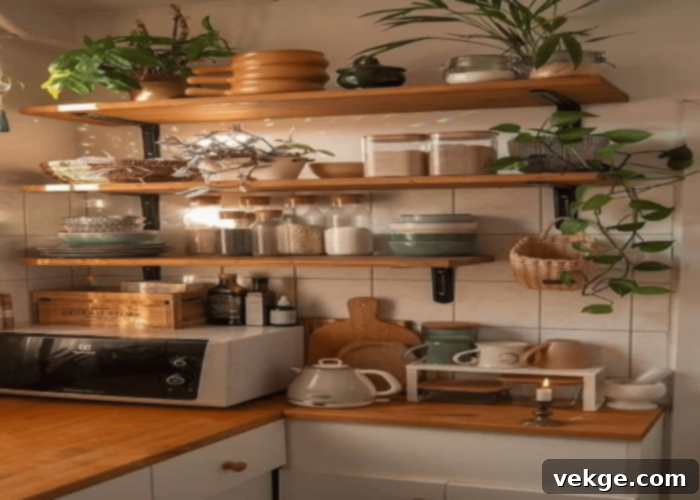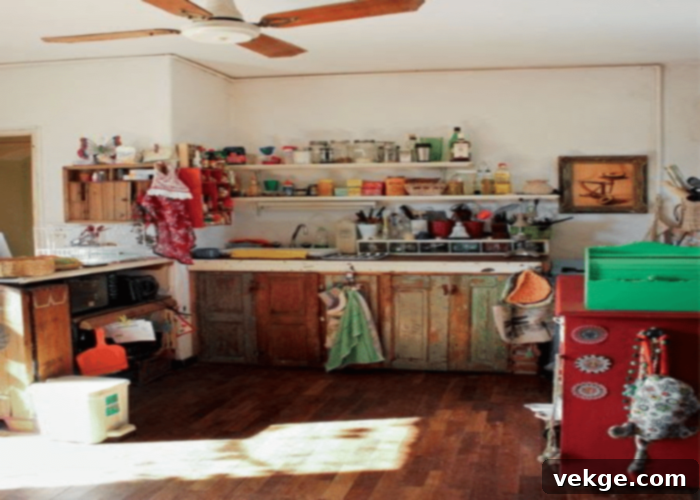Embrace Green Living: Sustainable Farmhouse Kitchen Decor Ideas for an Eco-Conscious Home
In an era where environmental awareness is no longer a niche concern but a global imperative, the choice to integrate sustainable practices into our daily lives has become essential. This growing consciousness extends seamlessly into our homes, especially in high-traffic areas like the kitchen. Sustainable solutions, often derived from natural resources, are increasingly trusted for their minimal environmental footprint, long-term durability, and surprising affordability. Their rising popularity stems from the transformative impact they have on living spaces, allowing us to create healthier, more harmonious environments that reflect a commitment to planetary well-being.
For those who cherish all things natural and desire their home decor to embody this philosophy, the farmhouse kitchen offers a perfect canvas. The rustic, wholesome aesthetic of a farmhouse naturally aligns with eco-friendly principles, celebrating simplicity, natural materials, and a connection to the land. By embracing sustainable farmhouse kitchen decor ideas, you can infuse your space with timeless charm while actively preserving natural fauna and flora, promoting biodiversity, and reducing your ecological impact. Let’s explore some of the best innovative ideas to give your farmhouse kitchen an eco-friendly transformation.
Top Sustainable Farmhouse Kitchen Decor Ideas
1. Introduce Sustainable Plywood Solutions
Plywood stands out as an exceptionally sustainable material, known for its robustness and resistance to wear and tear. When sourced responsibly, it has virtually no negative impact on indoor air quality, making it a healthy choice for your home. However, it’s crucial to verify that your plywood has not been exposed to harmful chemicals like formaldehyde, which can off-gas toxins. Always look for FSC-certified (Forest Stewardship Council) plywood, indicating it comes from sustainably managed forests, and opt for low-VOC (Volatile Organic Compound) or formaldehyde-free adhesives. This diligent selection ensures both the longevity and environmental integrity of the material.
Plywood is incredibly versatile and can be used to create stunning cabinetry, open shelving, feature walls, or even durable countertops when properly sealed. Its natural wood grain offers a warm, authentic aesthetic that complements the farmhouse style beautifully, adding a classic turnaround to a plain kitchen. By incorporating plywood, you not only enhance the feel of the space with a natural touch but also invest in a material that is built to last, reducing the need for frequent replacements and further minimizing waste.

2. Embrace Vintage and Upcycled Treasures
Completely overhauling a kitchen can be an expensive and resource-intensive endeavor. A more sustainable and character-rich approach is to integrate vintage and upcycled pieces. This allows your farmhouse kitchen to retain its charm while evolving into an eco-friendly sanctuary. The beauty of mixing old and new lies in the stories each piece tells and the unique personality they impart. Think beyond just swapping items; consider how you can repurpose existing furniture or hunt for timeless gems at antique shops, flea markets, or online marketplaces.
Imagine a sturdy antique wooden dresser repurposed as a kitchen island, or an old hutch transformed into a charming pantry. These pieces not only reduce landfill waste but also introduce unparalleled character and craftsmanship often missing in mass-produced items. Supplement these with eco-friendly alternatives for your everyday items: switch out plastic cutlery for sets made of bamboo or recycled metal, and replace ceramic bowls and plates with options crafted from natural materials like wood, bamboo, coconut shells, or recycled glass. These small, thoughtful changes contribute significantly to a sustainable lifestyle, making your kitchen both beautiful and environmentally responsible.

3. Design with Freestanding Kitchen Units
A growing trend in sustainable kitchen design is the concept of freestanding kitchens. Instead of custom-built, fixed cabinetry, this approach uses individual, movable units that are not permanently attached to walls or floors. This design philosophy offers unparalleled flexibility, allowing you to rearrange your kitchen layout as your needs evolve, or even take your kitchen with you if you move. It promotes a more adaptable and less permanent relationship with your home furnishings, a core tenet of sustainable living.
Freestanding units, which might include standalone cupboards, butcher blocks, prep tables, and dish racks, reduce the amount of construction waste typically generated during kitchen installations. They also make it easier to repair or replace individual pieces without affecting the entire kitchen, extending the lifespan of your setup. This timeless option encourages a relaxed, less rigid aesthetic that perfectly complements the informal charm of a farmhouse kitchen. It allows for creative placement and ensures you remain flexible with your appliances and decor, making your kitchen a truly dynamic and eco-conscious space.

4. Incorporate Terracotta Tiles
To elevate your farmhouse kitchen with a touch of warmth and history, consider the timeless appeal of terracotta tiles. Derived from natural clay, terracotta is one of the least toxic and most environmentally friendly flooring and wall materials available. Its distinctive earthy tones and rustic texture instantly infuse a space with character and a welcoming ambiance, perfectly echoing the natural aesthetic of a farmhouse.
Terracotta is microporous, meaning it needs proper sealing to protect it from moisture and stains. Once sealed, it becomes highly durable and surprisingly easy to maintain, requiring only gentle mopping with appropriate cleaners to keep it looking fresh and vibrant. Beyond its aesthetic appeal, terracotta boasts excellent thermal mass, helping to regulate indoor temperatures by absorbing heat during the day and releasing it slowly at night, potentially reducing energy consumption. This natural material offers a more durable and sustainable alternative to many synthetic options, making it an excellent choice for eco-conscious flooring or a charming backsplash in your kitchen.

5. Support Local Artisans & Decor
One of the most authentic and impactful ways to achieve an eco-friendly farmhouse kitchen is by sourcing your decor locally. Many skilled artisans dedicate their lives to crafting beautiful, high-quality products using sustainable materials and traditional methods. By choosing local decor, you not only brighten your space with unique, handmade pieces but also contribute to a sustainable economy by reducing the carbon footprint associated with long-distance shipping.
Shopping locally exposes you to a diverse range of products, from handcrafted pottery and custom-made wooden utensils to woven textiles and unique artworks, all manufactured by individuals in your community. These items are often created with a deep understanding of natural materials and are typically free from harmful toxins or chemicals found in mass-produced goods. This approach ensures your kitchen decor is not only beautiful and functional but also ethical and reliable. Moreover, supporting local businesses fosters community growth and helps preserve traditional craftsmanship, making your kitchen a reflection of both environmental consciousness and local pride.

6. Opt for Bamboo Window Treatments
Bringing natural elements into your kitchen without compromising aesthetics is easily achieved with bamboo window treatments. This environmentally sustainable idea is perfect for anyone seeking stylish and eco-conscious window solutions. Bamboo is renowned for its rapid growth rate and ability to self-regenerate from its roots, making it one of the most renewable resources on the planet. Its versatility allows for various applications, including elegant blinds, shades, and woven wood panels.
Adding bamboo to your windows introduces a calm and stable atmosphere to your kitchen. The inherent association of wood and natural fibers with well-being helps create a serene and grounded feeling. Beyond their aesthetic appeal, bamboo window treatments offer practical benefits: they filter natural light beautifully, provide privacy, and can even offer a degree of insulation, helping to keep your kitchen cooler in summer and warmer in winter. Investing in bamboo window treatments is a smart choice for both style and sustainability, perfectly aligning with an eco-friendly farmhouse ethos.

7. Choose Non-Toxic Paints and Finishes
When renovating or simply refreshing your farmhouse kitchen, the paints and finishes you choose play a crucial role in its overall environmental footprint and your indoor air quality. Traditional paints often contain high levels of Volatile Organic Compounds (VOCs), which can off-gas harmful chemicals into your home for years after application, contributing to respiratory issues and other health problems. Opting for non-toxic, low-VOC, or zero-VOC paints and finishes is a critical step towards creating a truly eco-friendly kitchen.
These healthier alternatives are available in a wide range of colors and finishes, allowing you to achieve the classic farmhouse aesthetic without compromise. Look for brands that use natural pigments and plant-based binders. Extending this philosophy to wood finishes for cabinetry, floors, and countertops means choosing natural oils, waxes, or water-based sealants over conventional varnishes. By selecting non-toxic options, you protect your family’s health, reduce environmental pollution during manufacturing, and ensure your beautiful kitchen remains a safe and breathable space.
8. Invest in Energy-Efficient Appliances
While often overlooked in decor discussions, appliances are central to any kitchen’s functionality and energy consumption. Upgrading to energy-efficient models is a vital component of creating a sustainable farmhouse kitchen. Modern appliances, such as refrigerators, dishwashers, and ovens, are designed to significantly reduce electricity and water usage compared to older models. Look for appliances with ENERGY STAR ratings, which certify that they meet strict energy efficiency guidelines set by the U.S. Environmental Protection Agency.
An energy-efficient dishwasher, for example, can save thousands of gallons of water annually, while a high-efficiency refrigerator uses less electricity to keep food fresh. Beyond the environmental benefits, these appliances translate into tangible savings on your utility bills over their lifespan. When choosing new appliances, consider their durability and repairability, opting for brands known for their longevity and readily available spare parts. Integrating these smart choices into your farmhouse kitchen not only conserves resources but also creates a more modern, cost-effective, and environmentally responsible space.
Final Thoughts on Creating Your Eco-Friendly Farmhouse Kitchen
The journey towards an eco-friendly farmhouse kitchen is a marathon, not a sprint. Small, thoughtful changes implemented consistently over time will ultimately have a profound and lasting impact. When it comes to embracing sustainability, every little effort goes a long way. Rather than embarking on an entirely new construction project, which often entails significant expenditure and resource consumption, focus on revamping your existing kitchen in an eco-friendly manner by weaving sustainable practices into your daily life.
There are countless ways to decorate your farmhouse kitchen space, ensuring it is both aesthetically pleasing and environmentally conscious. From selecting handcrafted products that infuse creativity and harmony into your space to making conscious choices about materials and appliances, each decision contributes to a healthier home and planet. Embrace the charm of natural elements, the history of vintage finds, and the innovation of sustainable design. Your eco-friendly farmhouse kitchen will not only be a beautiful place to gather but also a testament to your commitment to a greener future.
Frequently Asked Questions About Sustainable Farmhouse Kitchens
What Are Eco-Friendly Products?
Eco-friendly products are items designed to minimize negative impacts on the environment throughout their life cycle. This typically means they are made from recycled or sustainably sourced materials, are easy to reuse, repair, or recycle at the end of their life, and are produced using processes that conserve resources and reduce pollution. Common examples in a home setting include biodegradable cleaning products, sustainable furniture made from reclaimed wood or bamboo, natural fiber textiles, and energy-efficient appliances.
What Is an Eco-Friendly Kitchen?
An eco-friendly kitchen is a space designed and equipped to have the least possible detrimental effect on the environment, while also promoting a healthy living environment for its inhabitants. This involves a holistic approach, encompassing choices such as using sustainable and non-toxic building materials (like FSC-certified wood or recycled glass countertops), incorporating energy-efficient appliances and water-saving fixtures, utilizing antiques and vintage pieces to reduce waste, and decorating with items made from natural and renewable resources. It’s a kitchen that prioritizes both planetary health and personal well-being.
What Are the Benefits of Eco-Friendly Products?
The benefits of using eco-friendly products are extensive and far-reaching. Environmentally, they significantly reduce the stress on natural ecosystems by minimizing waste, conserving natural resources, and decreasing pollution. For individuals, these products often lead to a healthier home environment as they reduce exposure to harmful chemicals and toxins commonly found in conventional products, thereby preventing potential health problems. Furthermore, sustainable products are often designed for durability and longevity, offering excellent value and reducing the need for frequent replacements. In the long run, adopting eco-friendly choices fosters a more sustainable lifestyle that benefits both personal health and the planet.
